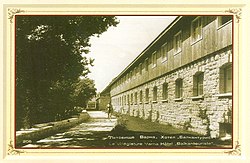Shopska salad (Bulgarian, Macedonian and Serbian: Шопска салата; Croatian: Šopska salata; Romanian: Salata bulgărească; Czech: Šopský salát; Albanian: Sallatë Fshati; Hungarian: Sopszka saláta; Greek: Σαλάτα σόπσκα) is a cold salad popular throughout Southeastern Europe.[1][2][3] It is Bulgaria's most famous salad and national dish.[4]
 Shopska salad as served in Bulgaria | |
| Alternative names |
|
|---|---|
| Type | Salad |
| Region or state | Southeastern Europe |
| Main ingredients | Tomatoes, cucumbers, onions, peppers, sirene |


Ingredients and serving
The dish is made from tomatoes, cucumbers, onion/scallions, raw or roasted peppers, and sirene, a white brined cheese similar to feta.[5][6] The vegetables are usually diced and salted, followed by a light dressing of sunflower oil (or olive oil, which is less authentic),[7] which is occasionally complemented by vinegar. The addition of vinegar contributes, however, to the sour flavour that the tomatoes impart. In restaurants, the dressings are provided separately. Lastly, the vegetables are covered in a thick layer of grated or diced sirene cheese. This salad is often consumed as an appetizer with rakia.
According to food anthropologist Rayna Gavrilova, the dish is commonly accompanied by a shot of apricot or other fruit brandy.[1]
Background and history
Tomatoes appeared in Southeastern Europe in the mid-1800s.[1]
In the post-war socialist era, Balkantourist focused on marketing Bulgaria's Black Sea coast as a tourist destination for Bulgarians and for western tourists as a way of showcasing the socialist "good life".[8] This included reinventing and remarketing regional dishes to identify them as Bulgarian rather than simply Eastern European.[8] The Shopska salad is a variation on a Greek salad[8]: 54 of cucumbers, tomatoes, and feta; Balkantourist in 1956 named their version Shopska salad.[8][9] The salad's colors, which mimic those of the Bulgarian flag, were a happy coincidence that was seen as a positive for evoking a national sentiment.[8][10][11]
Despite the fact that the salad's name comes from the westernmost Bulgarian region called Shopluk, it first appeared at the Black Sea coast, in a resort near Varna, called Druzhba in the restaurant "Chernomorets".[12][13] It can be found in one of the first state-approved cookbooks from 1956 (Sbornik recepti 1956, vol. 1, p. 50).[14][15] The development and popularization of the salad is attributed to a leader in Bulgarian tourism Petar Doychev (1924-2019).[16]
The dish was initially served in Bulgaria only in the hotels of Balkantourist.[15] It is the only survivor of five or six recipes similarly created for and marketed by the tourism industry.[15] It became an emblem of Bulgarian tourism.[17] It was approved as a national culinary symbol during the 1970s and 1980s.[18] In 2014 Shopska salad was Bulgaria's most recognizable dish in Europe. It was the most popular recipe in a European Parliament initiative called A Taste of Europe.[19]
Origin dispute
According to the Bulgarian edition of Deutsche Welle, the Balkantourist recipe spread from Bulgaria to the cuisine of neighboring countries.[20] Deutsche Welle noted a restaurant in Croatia claimed the salad as a Croatian national dish.[20] According to Radio Bulgaria and the Sofia News Agency, Serbian newspaper Politika in the 2000s claimed the salad as Serbian rather than Bulgarian, Macedonian or Czech.[21][22] Although the salad was promoted on the Black Sea coast, because its name refers to the area of Shopluk -- which is divided among Bulgaria, Serbia and North Macedonia -- after the breakup of Yugoslavia chefs in those areas began to contest the Bulgarian origin of the salad.[citation needed]
Similar dishes in other cuisines
References

